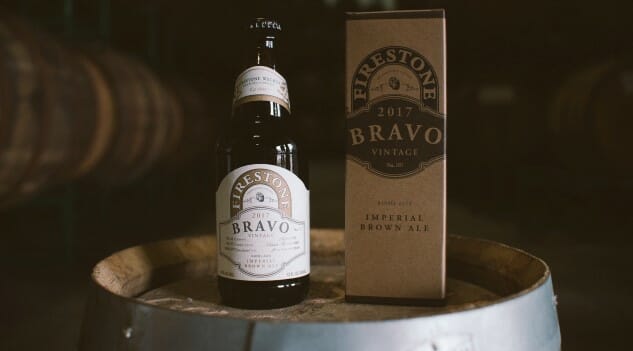Matt Brynildson of Firestone Walker on Downsizing Barrel-Aged Beers
Photos via Firestone Walker
Matt Brynildson knows as much about barrel-aging beer as nearly any other single person you could name in the American craft brewing industry. The beloved brewmaster of Firestone Walker in Paso Robles, CA, has headed the brewery’s barrel-aging efforts ever since the first time they put an imperial brown ale called Bravo into whiskey barrels in 2004. But in actuality, his barrel-aged roots go even deeper.
That’s because from 1996 until 2000, Brynildson was a brewer for Chicago’s Goose Island. Back in those halcyon, pre-Anheuser acquisition days, Goose Island pioneered the art of aging craft beer in used spirit barrels, most famously with Bourbon County Brand Stout—which you might call the barrel-aged stout that launched a thousand imitators, alongside contemporaries such as Founders Kentucky Breakfast Stout. It was here that Brynildson cut his teeth on the science of aging beer in spirits barrels for months or even years at a time. It was invaluable experience, to be sure … we wouldn’t have the likes of Firestone Walker Parabola today without it.
It made some waves, then, when Firestone Walker announced this week their intentions to make an interesting shift in their barrel-aged beer program. In addition to bottling Bravo for the first time, a beer they’ve been making (but never distributed) for 13 years, Firestone is setting a new precedent: Moving their barrel-aged beers to the same 12 oz bottles used for year-round stalwarts such as Union Jack IPA and Double Barrel Ale. No longer will any barrel-aged beers in the Firestone Walker Vintage Reserve series be available in their typical 22 oz containers. In 2017, even sought-after releases such as Parabola and Firestone Walker’s annual Anniversary Ale will be exclusively 12 oz. For reference, this series also includes Stickee Monkey, Velvet Merkin and Helldorado.
The response of beer geeks has been mixed, in exactly the sort of way that anyone who reads beer forums would predict. Many (myself included), like the concept as a way to both lessen the amount of beer you need to consume every time you open a barrel-aged bottle and as a way to potentially save a few bucks. Being a consummate beer omnivore, I rarely feel the need to purchase or drink large amounts of any one beer—all I really want is a serving, or a taste. Other fans have been less enthusiastic, citing a fondness for the “shareability” of 22 oz bottles and raising other questions about the move to 12 oz.
Wanting to take a few of my own questions to the man himself, I got Brynildson on the phone from California on Thursday afternoon. Here are some of his thoughts on the change in packaging, the release of Bravo after 13 years, and where the Firestone Walker barrel-aging program might go in the future.
Our conversation began with a brief reflection on Brynildson’s time at Goose Island that I won’t bother reproducing, except that he “learned a lot of what he knows about making beer” in his time there.
Paste: I’m curious—how satisfied were you with the earliest spirit barrel-aged beers at Firestone Walker? How was the first batch of Bravo, and after everything you’ve learned, is it much different 13 years later?
Brynildson: It really is quite similar, actually. It was designed to be a very different beer than say, Bourbon County Stout was … much drier, much less rich. The thing is, at that time you could have accused us of making mostly “pedestrian” beer styles, low-alcohol beers. Our portfolio wasn’t very aggressive. But then the 10th anniversary was coming up on the horizon, and we got the go-ahead to make something big, gnarly and awesome.
The original Bravo, though, was sort of like a side project to put in a barrel, a single batch brew that was created to be an element in the overall anniversary beer. We had a happy circumstance there in the fact that we didn’t have any kind of warehouse to put the barrels in, just our cold room. That really ended up differentiating our process from other breweries, because they were putting the barrels in an ambient temperature warehouse to kind of flux in temperature with the seasons. As a result, when we took the beer out of the barrel it had this wonderful, bright, non-oxidized malt character and we realized that we were on to something. It exceeded our expectations and convinced us to continue moving forward with our barrel-aging projects.
Paste: And Bravo has never gotten a proper release in all that time?
Brynildson: This is the first time ever. It’s weird that we have a beer this old that has never seen the light of day on its own. It’s always been in the program, every single year. It may have been on tap in the taproom at some point, but this will honestly be the first time that many people have ever tasted it outside of Anniversary Ale.
-

-

-

-

-

-

-

-

-

-

-

-

-

-

-

-

-

-

-

-

-

-

-

-

-

-

-

-

-

-

-

-

-

-

-

-

-

-

-

-










































